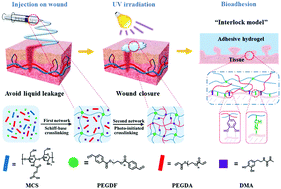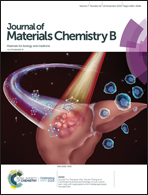A shear-thinning adhesive hydrogel reinforced by photo-initiated crosslinking as a fit-to-shape tissue sealant†
Abstract
Surgical sealants suitable for wounds with non-flat complex geometries are still a challenge to fulfill clinical requirements. Herein, a novel fit-to-shape sealant enhanced by photo-initiated crosslinking was developed utilizing maleic anhydride modified chitosan (MCS), benzaldehyde-terminated PEG (PEGDF) and polyethylene glycol diacrylate (PEGDA). Initially, the shear-thinning hydrogel prepared through the Schiff-base linkage between MCS and PEGDF could be injected into target sites, remolded to conform to a wound with non-flat complex geometry, and remain on the wound, avoiding adverse liquid leakage. Under illumination with ultra-violet (UV) light, the hydrogel was solidified in situ rapidly to adopt the wound contour and enhanced in adhesive strength to seal defects of the tissue. In addition, the hydrogel exhibits stability in extreme pH environments (pH = 1) and has potential to treat wounds inside the stomach with the existence of gastric acid. Moreover, the hydrogel can be applied as adhesive wound dressings through in situ 3D printing. Taken together, the fit-to-shape sealant enhanced by photo-initiated crosslinking can be considered as promising tissue adhesives for wound closure and other biomedical applications.



 Please wait while we load your content...
Please wait while we load your content...